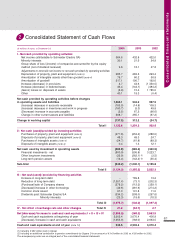APC 2004 Annual Report Download - page 59
Download and view the complete annual report
Please find page 59 of the 2004 APC annual report below. You can navigate through the pages in the report by either clicking on the pages listed below, or by using the keyword search tool below to find specific information within the annual report.
57
Business Review
In 2004, 97% of the manufacturing sites targeted by
the NEW2004 program received ISO 14001 certifica-
tion. The remaining 3% are involved in the certification
process. All certified facilities benefit from the contin-
uous improvement methodology set out in ISO 14001.
Products
Communication on environmental aspects has
become indispensable. As a result, the Company
issued a directive in 2004 calling for the publication of
a product environmental profile (PEP) for all new
products. Designed to provide information on environ-
mental performance throughout a product's life cycle,
the PEP is based on life cycle analysis (LCA) method-
ology. In particular, it describes the product's environ-
mental impact calculated using databases available to
the general public. This includes information on such
factors as natural resource consumption, greenhouse
forcing and ozone layer depletion.
In addition, Schneider Electric has committed official-
ly to complying with the EU Restriction of Hazardous
Substances (RoHS) Directive for all concerned prod-
ucts worldwide. As a result, we will eliminate lead,
mercury, cadmium, hexavalent chromium and bromi-
nated flame retardants from our electrical distribution
and low voltage industrial control products. A dedicat-
ed program has been developed to promote the nec-
essary measures in design, industrialization, purchas-
ing and production.
67 %
100 %
74 %
97 %
2002 2003Dec. 31,
2004
2004
target
NEW2004 objective:
Ensure that 100%
of our sites comply with ISO 14001
13 %
100 %
57 %
93 %
2002 2003Dec. 31,
2004
2004
target
NEW2004 objective:
Ensure that 100% of our new global products
comply with eco-design methodology
Environnemental performance
2002 2003 2004 at 2003 2004*
scope of
consolidation
Number of employees at our manufacturing sites 36,983 43,944 41,822 47,140
Amount of waste produced (in metric tons) 109,357 93,736 73,466 94,821
Amount of waste per production site employee
(in metric tons) 3 1,9 1,8 2
Percentage of waste recovered 53 65 78 73.5
Equivalent energy consumption (in MWh) 538,111 674,967 628,627 692,298
Energy consumption per production site employee
(in MWh) 14.6 15.3 15 14.7
Water consumption (in cubic meters) 1,805,608 1,643,483 1,625,380 1,838,221
Water consumption per production site employee
(in cubic meters) 49 37.4 38.9 39
* Data collected from 158 sites versus 139 in 2003
























